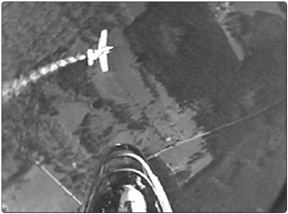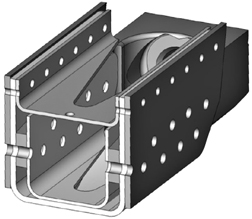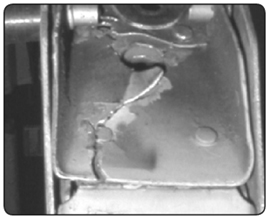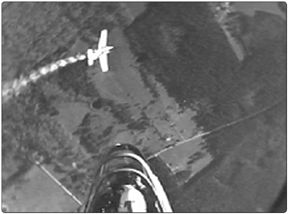
By Paul Bertorelli
With its sliding bubble canopy and high-testosterone power-to-weight ratio, the Siai-Marchetti SF260 is the sort of airplane that invites tired clichs like you dont fly it, you wear it. That makes it a natural for a tiny slice of general aviation devoted to giving John Q. Public a glimpse of living the large life of a fighter pilot, if just for an hour of simulated air combat against a like model. This was precisely my introduction to the SF260 about 10 years ago.
I wish I could say I cherished the experience. But I recall it as an hour of horsing around in a 5- or 6-G turn, half grayed-out and with most of my blood in my sneakers. I didnt blow my lunch but I was hardly Mr. Congeniality after we landed. Much of that flight was spent in high-G buffet, which is quite easy to do in the SF260, given its feather-light stick forces.I remember wondering how the airframe could possibly stand that kind of abuse, day in and day out, and did the guys operating the mock air combat outfit have a good hack on how the airframe would endure?
Had I bothered to ask, the answer might not have been encouraging. Mock air combat was a new thing then and operators were learning their lessons in the heat of battle, so to speak. The tuition would soon get very expensive.Within the space of four years, three Beechcraft T-34 Mentors involved in mock combat shed their wings and crashed with all hands-six fatalities altogether. The most recent crash in December 2004 grounded the entire T-34 fleet and hung a black flag over mock air combat as a means of breaking loose from the humdrum, boring existence of straight and level.
And the T-34 wasnt alone. In May 2005, a North American T-6 that had been used in mock air combat lost a wing and broke up near Kissimmee, Fla., again killing both occupants. The crashes raised a troubling question: Could it be that anything built less stoutly than an F-16 just couldnt take the abuse of daily air combat rides? Probably not, it turns out, but it took breaking three airplanes to grasp the vaguest dimension of the challenge. The larger lesson is that even strongly built airplanes can take only so much abuse, but owners of these airplanes-by exercising the slightest restraint-can yank and bank to their hearts content.
The T-34 Story
The T-34 Mentor wasnt specifically conceived as a military trainer; it got that way through expediency. In the early 1950s, the U.S. Air Force and Navy were betwixt and between the piston ages sunset and the dawn of jets. When the services needed a basic piston trainer, Beechcraft responded by reworking the Model 35 Bonanza into a tandem seating arrangement with sticks and a sliding canopy.
Significantly, the T-34 retained the same basic spar and structure of the Bonanza. The first of 873 T-34A and -B models went into service in 1953, for use as primary trainers. By the late 1970s, some of the airframes were converted to turbine power and many found their way to foreign air forces.Those that werent converted to turbines were surplussed by the military and soon became popular as affordable warbirds. (About 260 are in civilian hands today.)
A handful found their way into the mock air combat arena, a task for which they are seemingly well suited, given their obvious military antecedents.Trouble with the T-34 was a while in coming, but come it did. In 1999, a T-34 on a mock combat flight in Georgia shed its right wing and crashed, killing both pilots. Post-flight inspection revealed cracking in a part of the spar outboard of whats known in Beech airplanes as the bathtub fitting, a receptacle in the underside of the wing that provides access to the wing attach bolts. The FAA responded by issuing an Airworthiness Directive (AD) limiting T-34s to 2.5 Gs and 175 mph, pending further investigation.
That investigation was done in part by Raytheon which, two years after the 1999 crash, recommended a Draconian and expensive eddy current inspection at 80-hour intervals. Although the T-34 suffered mightily from its aura as a poor mans fighter aircraft, it benefited just as much for attracting a certain type of buyer-well-to-do owners with business experience and political connections, and the wherewithal to use both. These owners banded together into one of the most effective and well-run owner groups in the industry, the T-34 Association, Inc.
Worried that their airplanes would be rendered uneconomical by the Raytheon AD, the T-34 Association got busy with various vendors to develop alternate means of compliance to the AD, or AMOCs. Four were eventually developed and although each came at the problem differently, all of them did the same thing: buttressing the spars weak point and redistributing flight loads around the crack-prone area. Although the fixes were expensive and time-consuming, owners who wanted to keep flying their T-34s paid the money and had the work done.
That should have been the end of it. But it was not to be. In November 2003, another T-34 engaged in mock air combat lost its left wing and crashed in Conroe, Texas. Disturbingly, the airplane hadnt been modified with any of the AMOCs-a regulatory misstep the FAA has yet to explain-and the NTSBs investigation of the crash revealed that it had been flown well beyond the 2.5-G/150-knot limit that applied to unmodified airplanes. The FAA infuriated T-34 owners by again grounding the entire fleet, but the T-34 Association moved quickly and worked with the AMOC companies to get the airplane flying again; the grounding was short-lived.

But on December 7, 2004, Mentor owners were stunned to learn that yet another airplane had shed a wing and crashed, killing both occupants.Ominously, in this crash, the structural failure occurred in the wing center section, at a point unrelated to the cracks found outboard of the bathtub fitting. If the T-34 community fretted over yet another grounding, they didnt have to wait long to find out. Three days after the crash, the FAA issued emergency AD 2004-25-51, grounding the T-34 fleet pending another review of the airplanes wing structure and a potential fix.
Again, cognizant of its own economic interests, the T-34 Association launched what has become an intensive research project aimed mainly at restoring the T-34 to flight status, but also answering this elusive question: Just how much abuse can an airframe really take?
Load Study
In some ways, the T-34 Associations work is an expensive, painstaking re-invention of the wheel. Its no secret that airframes exposed to persistent high-G flight wear out faster than those flown inside a more benign envelope.The military has known this for years, and developed maintenance and inspection programs to deal with it. In the civil context, more has been left to chance-although any mechanic who maintains an aerobatic airplane flown hard knows that such airframes take a pounding.
But until the T-34 Association embarked upon its AD project, hard data describing the effect of high-G flight on civil aircraft was hard to come by.No one seemed to have good numbers. But the numbers, once obtained, proved to be utterly startling. Moreover, if the science proves to be accurate-and theres no reason to believe it wont-airframes like the T-34 can be flown aerobatically safely for the foreseeable future, provided certain limits are observed.
Much of the fundamental work in defining those limits was done by George Braly and Tim Roehl at General Aviation Modifications, Inc. (GAMI), in Ada, Okla. Braly and Roehl happen to own a T-34, and developed one of the four AMOCs to address the bathtub fitting failures following the 1999 crash. Working with the T-34 Association, GAMI devised a test/research protocol to model the T-34 wing-spar lifetime.
The modeling GAMI performed explored five flight profiles, all based on relatively accurate known variables. One described the loads experienced by the Lima Lima flight team, a T-34 demo organization, during a typical show.At the opposite extreme was an aggressive mock air combat mission of the sort flown by the companies suffering wing failures.
According to the T-34 Associations review of air combat tapes, the real numbers were almost certainly higher than that and the modeling assumed only straight pulls, not the rolling G loading that the airplanes were exposed to.Rolling loads pull spars asymmetrically, concentrating loads rather than allowing the entire spar structure to carry the stress.
Using this data, the T-34 group hired a company called RaeTech to conduct computerized finite element analysis on the Mentors spar section, the results of which were fed into another program called AFGROW, which predicts crack propagation based on specified load levels. This purely statistical analysis predicted how many flight hours would elapse before half the spars would fail.
No one was especially surprised to learn that the modeling revealed that, barring corrosion or other insults, the spar would essentially last forever, with some 880,000 hours required to reach a 50-percent failure rate if flown in a low-G profile. But when the airplane was wrung out and pushed frequently to nearer its structural limit, spar life declined to a fraction of that for an airplane flown more gently, specifically a mere 6000 hours, a total eerily close to the total time on the crashed T-34s.
Although 880,000 sounds like a lot of hours, whats most telling is the ratio between the highs and lows. Put another way, in terms of wear and tear on the spar, one hour of high-G aerobatics-between 5 G and 6 G-is equivalent to seven hours of less vigorous flying, and perhaps more.
Further, the modeling revealed a much lower incidence of failure in spars exposed to 4 G to 5 G than those which endured the positive 6 G most of us assume to be the aerobatic limit. The study suggests that avoiding excursions from 5 G positive to 1 or 2 G negative reduces wear and tear on structures by a factor of two-to-one or more.
Failures are non-linear with G loading, Braly told us. Lop off the high-G end of the spectrum and you double the spar life. Limit it to under 5 G and you might quadruple it.
Aftermath
After the second T-34 crash, the NTSB observed, and the T-34 Association concurred, that there were actually two fleets of Mentors: those that had been flown in air combat and those that hadnt. In its efforts to direct the FAA toward a more reasonable AD response, the T-34 Association convinced the agency that-instead of simply throwing more metal at the problem-it would be more sensible to carefully review each airplanes history and then inspect the spars for signs of further cracking.

In early work on the original AMOC, GAMI had inspected 5400 bolt holes in 100 T-34 wing sections. Only one crack was found in, not coincidentally, an airplane used in mock air combat.
As of the summer of 2005, about 120 T-34s had been returned to flight status after logbook reviews and eddy current inspections of the affected spar sections. Not surprisingly, only two airplanes were found to have cracking of concern during these inspections, something which, for the short-term at least, validates the T-34 Associations approach to returning the airplanes to flight status.
The larger lesson is what the T-34 experience has taught us about airframes and aerobatics. Many airframes may be stressed for 6 G, but they can be used up by abuse.
I think we would all be well-advised to limit aerobatic flight to 5 G, says George Braly. If you go out to 6 G, it should be a rare event.
Also With This Article
“Measuring Stress”
“Field Practice”
“So, You Dont Do Acro?”
-Paul Bertorelli is editor of Aviation Consumer and editorial director for Aviation Safety.




